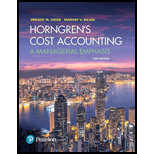
Price and efficiency variances, benchmarking. Nantucket Enterprises manufactures insulated cold beverage cups printed with college and corporate logos, which it distributes nationally in lots of 12 dozen cups. In June 2017, Nantucket produced 5,000 lots of its most popular line of cups, the 24-ounce lidded tumbler, at each of its two plants, which are located in Providence and Amherst. The production manager, Shannon Bryant, asks her assistant, Joel Hudson, to find out the precise per-unit budgeted variable costs at the two plants and the variable costs of a competitor, Beverage Mate, who offers similar-quality tumblers at cheaper prices. Hudson pulls together the following information for each lot:

- 1. What is the budgeted variable cost per lot at the Providence Plant, the Amherst Plant, and at Beverage Mate?
Required
- 2. Using the Beverage Mate data as the standard, calculate the direct materials and direct manufacturing labor price and efficiency variances for the Providence and Amherst plants.
- 3. What advantage does Nantucket get by using Beverage Mate’s benchmark data as standards in calculating its variances? Identify two issues that Bryant should keep in mind in using the Beverage Mate data as the standards.
Want to see the full answer?
Check out a sample textbook solution
Chapter 7 Solutions
Horngren's Cost Accounting, Student Value Edition Plus MyLab Accounting with Pearson eText - Access Card Package (16th Edition)
 Cornerstones of Cost Management (Cornerstones Ser...AccountingISBN:9781305970663Author:Don R. Hansen, Maryanne M. MowenPublisher:Cengage Learning
Cornerstones of Cost Management (Cornerstones Ser...AccountingISBN:9781305970663Author:Don R. Hansen, Maryanne M. MowenPublisher:Cengage Learning
